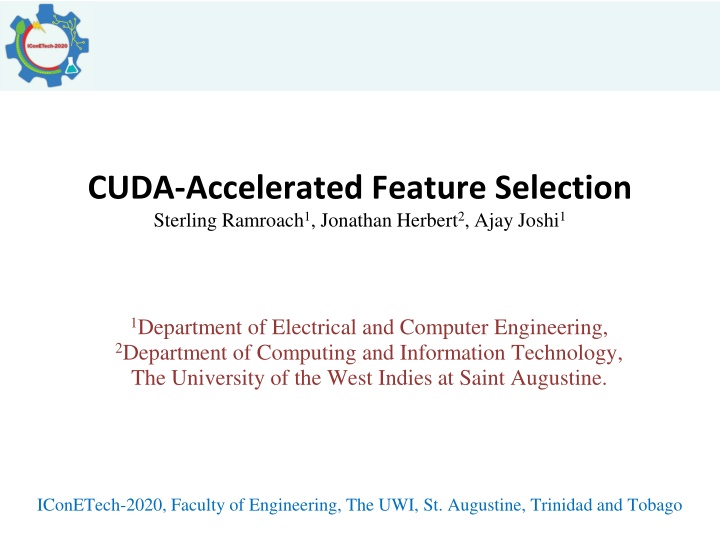
CUDA-Accelerated Feature Selection Using Pearson Correlation on GPUs
This study presents a method to enhance the performance of feature selection using Pearson Correlation on CUDA-enabled GPUs. By leveraging GPU parallelization, the framework achieves significant improvements in computation speed compared to conventional CPU processing. The results demonstrate the efficacy of this approach in efficiently identifying important features from high-dimensional data.
Uploaded on | 3 Views
Download Presentation

Please find below an Image/Link to download the presentation.
The content on the website is provided AS IS for your information and personal use only. It may not be sold, licensed, or shared on other websites without obtaining consent from the author. If you encounter any issues during the download, it is possible that the publisher has removed the file from their server.
You are allowed to download the files provided on this website for personal or commercial use, subject to the condition that they are used lawfully. All files are the property of their respective owners.
The content on the website is provided AS IS for your information and personal use only. It may not be sold, licensed, or shared on other websites without obtaining consent from the author.
E N D
Presentation Transcript
CUDA-Accelerated Feature Selection Sterling Ramroach1, Jonathan Herbert2, Ajay Joshi1 1Department of Electrical and Computer Engineering, 2Department of Computing and Information Technology, The University of the West Indies at Saint Augustine. IConETech-2020, Faculty of Engineering, The UWI, St. Augustine, Trinidad and Tobago
PROBLEM Identifying important features from high dimensional data is usually done using one- dimensional filtering techniques. Discard noisy and irrelevant attributes Time-consuming Scope for acceleration via high performance computing techniques involving the graphics processing unit (GPU). IConETech-2020, Faculty of Engineering, The UWI, St. Augustine, Trinidad and Tobago
OBJECTIVE To improve the performance of Univariate Feature Selection (Pearson correlation coefficient) by using parallelization on CUDA-enabled GPUs Compute Unified Device Architecture (CUDA) This framework facilitates the seamless scaling of computation on any CUDA-enabled GPUs IConETech-2020, Faculty of Engineering, The UWI, St. Augustine, Trinidad and Tobago
METHODOLOGY Pearson Correlation is used as a measure of the relevance for a feature with respect to the response variable The population Pearson correlation is defined as follows Since we use this on sample, the Pearson correlation is defined as follows IConETech-2020, Faculty of Engineering, The UWI, St. Augustine, Trinidad and Tobago
METHODOLOGY The Pearson Correlation is calculated on the GPU using CUDA kernels in the following architecture IConETech-2020, Faculty of Engineering, The UWI, St. Augustine, Trinidad and Tobago
RESULTS CPU vs GPU Average Runtime and Standard Deviation CPU Runtime (s) GPU Runtime (s) Number of Features, K 1 0.8 +/- 0.75 0.16 +/ 0.12 10 1.2 +/- 0.40 0.16 +/ 0.12 100 2.8 +/- 0.98 0.16 +/ 0.12 1000 29 +/- 1.55 0.16 +/ 0.12 10000 246 +/- 10.83 0.20 +/ 0.12 All experiments were performed on a 64-bit Windows 10 operating system with an Intel(R) Core (TM) i7-8750H CPU and an Nvidia GeForce GTX 1060 with 1,280 CUDA cores IConETech-2020, Faculty of Engineering, The UWI, St. Augustine, Trinidad and Tobago
RESULTS Time (s) Epochs CPU vs GPU Runtime IConETech-2020, Faculty of Engineering, The UWI, St. Augustine, Trinidad and Tobago
CONCLUSION Feature selection removes noisy or irrelevant variables in high dimensional data. We use the Pearson Correlation Coefficient as a method for determining which features are highly correlated with a target and are thus most important in the data. Since we use the Pearson Correlation Coefficient, we can treat our features as independent of each other and use GPUs to process them individually. This accelerates the feature selection process for datasets with a large number of features. IConETech-2020, Faculty of Engineering, The UWI, St. Augustine, Trinidad and Tobago
REFERENCES [1] G. Chandrashekar and F. Sahin, A survey on feature selection methods, Computers & Electrical Engineering, vol. 40, no. 1, pp. 16 28, 2014. [2] J. Nickolls, I. Buck, and M. Garland, Scalable parallel programming, in 2008 IEEE Hot Chips 20 Symposium (HCS), pp. 40 53, IEEE, 2008. [3] D. B. Kirk and W. H. Wen-Mei, Programming massively parallel processors: a hands-on approach. Morgan kaufmann, 2016. [4] D. Guide, Cuda c programming guide, NVIDIA, July, 2013. [5] O. Soufan, D. Kleftogiannis, P. Kalnis, and V. B. Bajic, Dwfs: a wrapper feature selection tool based on a parallel genetic algorithm, PloS one, vol. 10, no. 2,p. e0117988, 2015. [6] M.-S. Yang and K. P. Sinaga, A feature-reduction multi-view k-means clustering algorithm, IEEE Access, vol. 7, pp. 114472 114486, 2019. [7] F. Li, Y. Yin, J. Shi, X. Mao, and R. Shi, Method of feature reduction in short text classification based on feature clustering, Applied Sciences, vol. 9, no. 8, p. 1578,2019. [8] S. Xu, X. Yang, H. Yu, D.-J. Yu, J. Yang, and E. C. Tsang, Multi-label learning with label-specific feature reduction, Knowledge-Based Systems, vol. 104, pp. 52 61, 2016. [9] A. Phinyomark, P. Phukpattaranont, and C. Limsakul, Feature reduction and selection for emg signal classification, Expert systems with applications, vol. 39,no. 8, pp. 7420 7431, 2012. [10] I. Guyon and A. Elisseeff, An introduction to variable and feature selection, Journal of machine learning research, vol. 3, no. Mar, pp. 1157 1182, 2003. [11] N. Nekuri, and M. Sookshma. Adaptive Feature Selection and Classification Using Optimization Technique. In Frontiers in Intelligent Computing: Theory and Applications, pp. 146-155. Springer, Singapore, 2020. [12] S. Eulalia, J. Kacprzyk, and P. Bujnowski. Attribute Selection via Hellwig s Algorithm for Atanassov s Intuitionistic Fuzzy Sets. In Computational Intelligence and Mathematics for Tackling Complex Problems, pp. 81-90. Springer, Cham, 2020. [13] J. Benesty, J. Chen, Y. Huang, and I. Cohen, Pearson correlation coefficient, in Noise reduction in speech processing, pp. 1 4, Springer, 2009. [14] J. Gonzalez-Dom nguez, R. R. Exposito, and V. BolonCanedo, Cuda-jmi: Acceleration of feature selection on heterogeneous systems, Future Generation Computer Systems, vol. 102, pp. 426 436, 2020. [15] T. D. V. Swinscow, M. J. Campbell,et al.,Statistics at square one. Bmj London,2002.
Q&A IConETech-2020, Faculty of Engineering, The UWI, St. Augustine, Trinidad and Tobago
